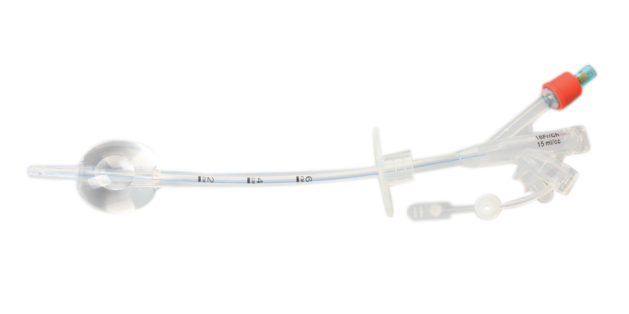
Gastrostomy Feeding Tube
Feeding tubes are used to provide nutrition to those who can't eat or drink by mouth.
Size: 12, 14, 16, 18, 20,22, 24, Fr/Ch.
A gastrostomy feeding tube is a medical device that is used to provide nutrition to people who cannot eat by mouth. The tube is inserted through the stomach wall and into the stomach. This allows food and liquids to be delivered directly to the stomach, bypassing the mouth and esophagus. Gastrostomy feeding tubes are used for a variety of reasons. Some people have conditions that make it difficult or impossible to swallow. Others may have had surgery that removed part of their digestive system, making it necessary to receive nutrition through a gastrostomy tube. Gastrostomy feeding tubes can be temporary or permanent. They can also be placed with surgery or endoscopically (through the mouth). The type of gastrostomy tube will be determined based on the individual’s needs. Temporary gastrostomy tubes are often used for people who need nutrition support for a short period of time, such as after surgery. These tubes are usually placed endoscopically and can be removed when they are no longer needed. Permanent gastrostomy tubes are typically placed with surgery. These tubes cannot be removed and will need to be replaced every few years. People with permanent gastrostomy tubes will need to learn how to care for their tube and manage their own nutrition.
A gastrostomy feeding tube (G-tube) is a medical device that is inserted through the stomach wall. It is used when someone is unable to take food by mouth, or when there is a need to provide nutrition directly to the stomach. A G-tube can be temporary or permanent. It can be placed with local anesthesia in an outpatient setting, or it may require general anesthesia and hospitalization. The type of G-tube will be determined by the individual’s needs. There are many reasons why someone may need a G-tube. Some common reasons include:
• Difficulty swallowing due to stroke, neurologic conditions, or head and neck cancer
• Gastrointestinal surgery that has resulted in an inability to eat by mouth
• Severe trauma to the face or head
• Persistent vomiting from conditions such as chemotherapy, radiation therapy, or kidney failure
A G-tube can also be used for people who are receiving parenteral nutrition (IV nutrition). This is a form of nutrition that bypasses the digestive system and delivers nutrients directly into the bloodstream. Parenteral nutrition may be needed if someone has an intestinal blockage, malabsorption syndromes, or short bowel syndrome. The decision to place a G-tube should be made by a team of healthcare providers who are familiar with the individual’s medical history and nutritional needs. The tube should only be placed after all other options have been considered and it is determined that a G-tube is the best option for the individual. Once a G-tube is in place, regular care and maintenance is required to prevent infection and other complications. The tube will need to be flushed with water after each feeding, and the skin around the stoma (the opening where the tube enters the stomach) will need to be cleaned daily. The tube should be checked regularly for leaks, blockages, or other problems. A G-tube can greatly improve the quality of life for someone who is unable to eat by mouth. It can provide them with the nutrition they need to stay healthy and avoid complications from malnutrition.
There are several types of gastrostomy feeding tubes, each with its own advantages and disadvantages. The type of tube that is best for a particular patient depends on many factors, including the patient’s age, health, and lifestyle. The most common type of gastrostomy feeding tube is the percutaneous endoscopic gastrostomy (PEG) tube. This type of tube is inserted through the skin into the stomach using an endoscope, a long, thin tube with a light and camera at the end. PEG tubes are usually left in place for long-term use. Another common type of gastrostomy feeding tube is the nasogastric (NG) tube. NG tubes are inserted through the nose and down the throat into the stomach. They are often used for short-term feeding when patients cannot eat by mouth or when they need to be fed more slowly than usual. Other types of gastrostomy feeding tubes include jejunostomy (J) tubes and transpyloric (T) tubes. J-tubes are inserted through the skin into the small intestine, while T-tubes are inserted through the skin into the stomach and then passed through to the small intestine. These types of tubes are often used when patients cannot tolerate PEG or NG tubes or when they need long-term access to their small intestine for nutrition purposes.
If you have a gastrostomy feeding tube, it is important to follow a healthy diet to make sure you are getting the nutrition you need. Here are some tips on what foods to eat:
• Eat small, frequent meals throughout the day.
• Choose high-protein foods such as lean meat, chicken, fish, tofu, legumes, and eggs.
• Include plenty of fruits and vegetables in your diet.
• Opt for whole-grain breads and cereals.
• Avoid sugary drinks and foods high in fat.